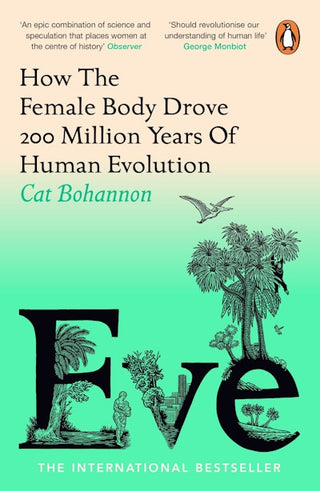Eve: How The Female Body Drove 200 Million Years of Human Evolution
- Unit price
- / per
-
Author:BOHANNON Cat
-
ISBN:9781529156171
-
Publication Date:September 2024
-
Edition:1
-
Pages:624
-
Binding:Paperback
-
Publisher:Hutchinson
-
Country of Publication:USA


A Back Order button means that we don’t have the book in stock at our store. It may already be on order – or we can order it for you from a publisher or distributor at no additional cost.
As we source items from around the globe, a back-order can take anywhere from 5 days to several weeks to arrive, depending on the title.
To check how long this might take, you’re welcome to contact us and we can provide an ETA or any other information you need. We recommend checking the timeframe before committing to an online order.
Eve: How The Female Body Drove 200 Million Years of Human Evolution
- Unit price
- / per
-
Author:BOHANNON Cat
-
ISBN:9781529156171
-
Publication Date:September 2024
-
Edition:1
-
Pages:624
-
Binding:Paperback
-
Publisher:Hutchinson
-
Country of Publication:USA
Description
A New York Times bestseller
Foyle's Non-Fiction Book of the Year 2023
Longlisted for Blackwell's Non-Fiction Book of the Year 2023
A Guardian, Telegraph and Prospect Best Book of 2023
How did wet nurses drive civilization? Are women always the weaker sex? Is sexism useful for evolution? And are our bodies at war with our babies?
In Eve, Cat Bohannon answers questions scientists should have been addressing for decades. With boundless curiosity and sharp wit, she covers the past 200 million years to explain the specific science behind the development of the female sex. Eve is not only a sweeping revision of human history, it-s an urgent and necessary corrective for a world that has focused primarily on the male body for far too long. Bohannon-s findings, including everything from the way C-sections in the industrialized world are rearranging women's pelvic shape to the surprising similarities between pus and breast milk, will completely change what you think you know about evolution and why Homo sapiens have become such a successful and dominant species, from tool use to city building to the development of language.
Adding product to your cart
You may also like
A Back Order button means that we don’t have the book in stock at our store. It may already be on order – or we can order it for you from a publisher or distributor at no additional cost.
As we source items from around the globe, a back-order can take anywhere from 5 days to several weeks to arrive, depending on the title.
To check how long this might take, you’re welcome to contact us and we can provide an ETA or any other information you need. We recommend checking the timeframe before committing to an online order.
You may also like
You may also like
-
A New York Times bestseller
Foyle's Non-Fiction Book of the Year 2023
Longlisted for Blackwell's Non-Fiction Book of the Year 2023
A Guardian, Telegraph and Prospect Best Book of 2023
How did wet nurses drive civilization? Are women always the weaker sex? Is sexism useful for evolution? And are our bodies at war with our babies?
In Eve, Cat Bohannon answers questions scientists should have been addressing for decades. With boundless curiosity and sharp wit, she covers the past 200 million years to explain the specific science behind the development of the female sex. Eve is not only a sweeping revision of human history, it-s an urgent and necessary corrective for a world that has focused primarily on the male body for far too long. Bohannon-s findings, including everything from the way C-sections in the industrialized world are rearranging women's pelvic shape to the surprising similarities between pus and breast milk, will completely change what you think you know about evolution and why Homo sapiens have become such a successful and dominant species, from tool use to city building to the development of language. -
-
Author: BOHANNON CatISBN: 9781529156171Publication Date: September 2024Edition: 1Pages: 624Binding: PaperbackPublisher: HutchinsonCountry of Publication: USA
A New York Times bestseller
Foyle's Non-Fiction Book of the Year 2023
Longlisted for Blackwell's Non-Fiction Book of the Year 2023
A Guardian, Telegraph and Prospect Best Book of 2023
How did wet nurses drive civilization? Are women always the weaker sex? Is sexism useful for evolution? And are our bodies at war with our babies?
In Eve, Cat Bohannon answers questions scientists should have been addressing for decades. With boundless curiosity and sharp wit, she covers the past 200 million years to explain the specific science behind the development of the female sex. Eve is not only a sweeping revision of human history, it-s an urgent and necessary corrective for a world that has focused primarily on the male body for far too long. Bohannon-s findings, including everything from the way C-sections in the industrialized world are rearranging women's pelvic shape to the surprising similarities between pus and breast milk, will completely change what you think you know about evolution and why Homo sapiens have become such a successful and dominant species, from tool use to city building to the development of language.-
Author: BOHANNON CatISBN: 9781529156171Publication Date: September 2024Edition: 1Pages: 624Binding: PaperbackPublisher: HutchinsonCountry of Publication: USA
-



